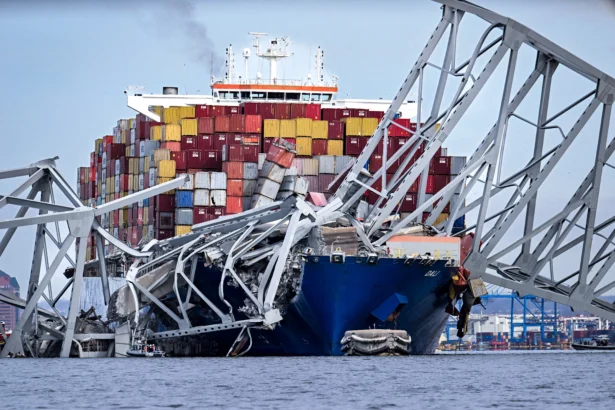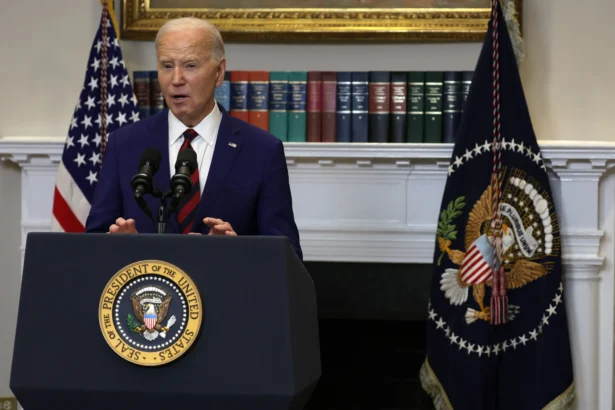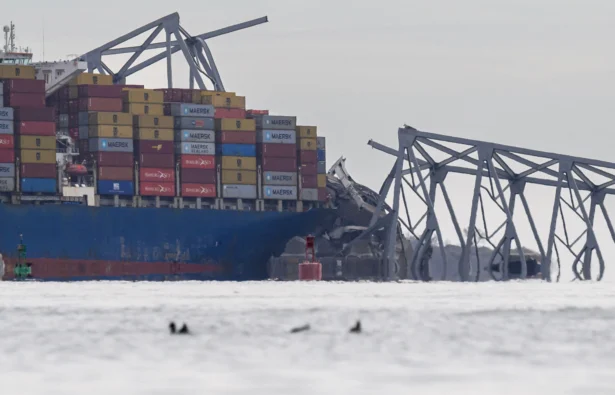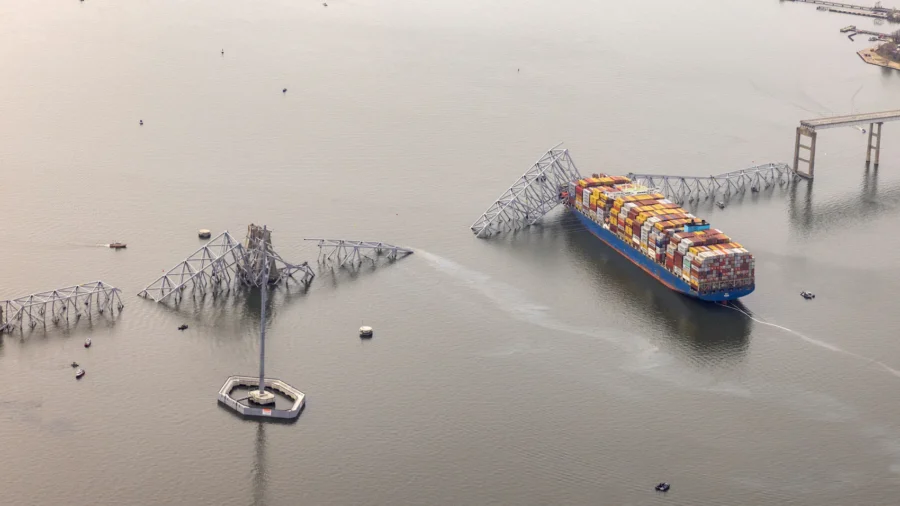It took only moments for a three-football-field-long, 95,000-ton container carrier loaded with 262,000 tons of cargo to ram and knock down parts of the Francis Scott Bridge in Baltimore, but it could take years—decades—to sort out liabilities and award insurance claims.
In fact, according to Grady S. Hurley, a maritime attorney with New Orleans-based Jones Walker LLP, “it will be weeks, if not months” to merely ascertain the extent of damages, never mind determine who or what is at fault for the allision.
It’s going to be a while “before all of the insurance is raveled or unraveled in the sense that there are various different types of claims, various levels of coverages, and just like [the media] is asking questions, underwriters also asking questions for which there are no simple or immediate answers,” he said.
Mr. Hurley is the president-elect of the Maritime Law Association of the United States and spoke to The Epoch Times only to provide “general background” on how the legal process in maritime legal issues and insurance claims generally unfolds.
“It would be irresponsible to talk in particulars. It’s not fair to anybody” at this point, he said. “In the face of this, attorneys always [follow] process and procedure” in representing “both the insured and the insurance interest.
“They’re gathering facts and information and this is a very complex set of facts, although you say ‘Oh, it’s very simple. There was an allision’—which starts with an ‘a’ instead of a starting collision with a ‘c’—and it should be as simple as that. But in maritime law, it never it is simple because of all of its interests that are affected.”
Right now, at least in public, for all involved, Mr. Hurley said “the focus right now is on response and recovery. The first-things-first thing always is people. And there are, as you’ve seen, both in the news and otherwise, rescue missions due to a loss of life, while at the same time recognizing that there’s people, property, and communities that are involved.”
Once the initial shock and recovery phase is over, the lawyers take over. “You have to look at this as a multi-dimensional sort of chess with different interests at different levels,” he said.
Right now, there’s less known than unknown in how the cargo ship, the Dali, lost power and rammed the bridge, Mr. Hurley said.
“There’s more speculation than facts right now. Folks need to take a deep breath and assess the situation and establish various priorities between all the interested parties,” he said before plotting out various liabilities and losses that could ultimately factor into assessing who pays who for what.
“You have the port authority, which is thinking how this is affecting commerce with all the alternatives to intermodal transportation,” Mr. Hurley said.

That, Insurance Information Institute spokesperson Loretta Worters told The Epoch Times, means there will be “contingent business interruption” insurance claims by many parties, not just around Baltimore Harbor but around the world—especially in Sri Lanka, where the ship was headed.
These suits will be in reference to “supply chain issues. There’s something [now in Baltimore Harbor] that needed to get to a certain port, and now it’s been ruined,” she said. “So the claim will likely involve several insurers and reinsurers. There’s going to be subrogation and legal issues. All that is going to take a lot of time to figure out.”
Then, “You’ve got the Corps of Engineers and you’ve got the state, figuring out what [the damage is] to waterways being blocked and what do we do about that.” Mr. Hurley said.
Merely sorting through involved parties will require time. Dali is owned by a Singapore-based group, Grace Ocean Pte. Ltd., which is owned by a group based in Hong Kong and was carrying cargo on behalf of the Danish shipping company, Maersk, according to Reuters. The ship is operated by Synergy Marine, also based in Singapore.
President Joe Biden delivers remarks on the collapse of the Francis Scott Key Bridge in Baltimore in the Roosevelt Room of the White House on March 26, 2024. (Alex Wong/Getty Images)
In response to the allision, President Joe Biden said he would request Congress provide whatever funding is needed to get the bridge back up as quickly as possible.
“I think the president wanted to say he does not want to delay the construction of the bridge. He will go ahead and ask for the money from Congress to fully fund the bridge construction and then we’ll probably settle that later with reinsurance,” Ms. Worters said.
But how that process will work with reinsurers is uncertain. “I think he’s trying to expedite things, which is great, but you know, in terms of the process, I’m not sure” who ultimately will pay what and when that will happen.

Then, there are personal injury claims and property claims, and “when cargo interests are involved,” there is the “general average claim,” Mr. Hurley said, which is a liability process under maritime law that generally makes cargo owners, not ocean carriers, liable for loss or damage to cargo as well as to the ship itself.
That may not be the case in the Dali’s ramming of the Francis Scott Key bridge.
“It’ll probably be the shipping company” that could be liable, “but that really depends on what the findings are,” Ms. Worters said. “It’s going to be a very complex case, of course, so there’s so many things that are involved with it.”
Reinsurance companies, which essentially provide insurance for insurance providers, “will bear the bulk of the insured cost of the collapse of the bridge,” she said. “There’s going to be liability coverage for most of the shipping vessels, so it really depends on [legal determinations]. But that’s the way it’s looking—reinsurers will be bearing the bulk of the cost of the collapse of the bridge.”
She said it is incorrect that “general average claim” liability is automatically assumed when there is evidence of human error by the ship’s crew or ship’s owners.
“People who have cargo on that ship are not going to be responsible for the damage,” Ms. Worters said, noting liability will be ascertained by “where the negligence lies. It would be the ship, the owners of the ship, [that] would be most likely responsible.”
That could further complicate legal and insurance determinations, Mr. Hurley said.
“You’ve got ship owners considering whether or not they’re going to file a limitation of liability proceeding,” he said. “And you also have attorneys representing individuals and corporations thinking, ‘You know, when should I file suit? Where should I file suit?’ Because lawyers are always thinking about the form and the jurisdiction that may resolve the claims in a most efficient way and, some may say, in a favorable way to their interest.”
He expects “some sort of National Transportation Safety Board (NTSB) or investigation that the Coast Guard will participate in, as well as all of the interested parties” in ascertaining insurance liabilities.

The NTSB, indeed, has opened an investigation into the crash. NTSB chair Jennifer Homendy announced the investigation from Baltimore in early afternoon.
The 24-member investigation team began to collect information immediately, she said, including data on the vessel’s operations, safety history, safety record, and operator.
“We have a human performance expert here. We have an engineering team. We have survival factors. And then we have a team here that is getting the recorders,” she said, referring to voice and data recorders aboard the ship.
“As the various damages and claims are identified,” Mr. Hurley continued, “it will trigger various insurance coverages and the underwriters will look at their policies and or manifests and or club rules to determine the scope of the coverage.”
Ultimately, he said, the landslide of lawsuits the allision will engender are likely to be “consolidated, probably in a federal court form, to handle all the various interests.”
Mr. Hurley said the proceedings are likely to unfold “maybe similar to what you saw in the Deepwater Horizon incident in the Gulf of Mexico where there was loss of life and vessel interest and community interest and all that was consolidated before a federal court judge who then set an orderly process to address all the various claims and interests and to provide a forum for folks to rationally work through all the questions.”
Deepwater Horizon involved criminal case liability and was prosecuted under the Clean Water Act, producing the largest criminal penalty levied against a single entity in U.S. history when BP pled guilty to the April 2010 accident in late 2012 and was fined $4 billion.

There may not be any criminal liabilities in the Dali’s crash into the Francis Scott Key bridge, which some, including Insurance Insider magazine, claim could be “one of the greatest losses” in the history of maritime infrastructure, with others saying the ultimate price tag could exceed the $1.5 billion paid out by insurers for the 2012 cruise ship Costa Concordia allision with an underwater ledge in the Mediterranean Sea.
Any damage estimate at this point is speculative, Mr. Hurley and Ms. Worters agreed.
“It depends on a lot of factors. What’s the price of metal, for example. Different things are going up in price today. [The bridge] was built in 1977 so to rebuild a bridge is going to be a lot more expensive today than it was 50 years ago.”
Some already have culpable culprits in their sites: a global maritime transport system where massive ships on tight timelines are encouraged to go fast and ask safety questions later.
“As we await a formal investigation from the NTSB, we are soberly reminded of the cruel phrase in our industry that ‘rules are written in blood,’” the Marine Engineers’ Beneficial Association said in a statement.
“This unfortunate incident highlights the need for strong safety standards in the global maritime industry that fall short of those in the U.S. merchant marine,” it said. “While we continue to learn more about what happened on this tragic day, all global ship operators must avoid future accidents contributed by poor working and operating standards that utilize minimum crewing for profit at the expense of human life and safety.”
From The Epoch Times.


